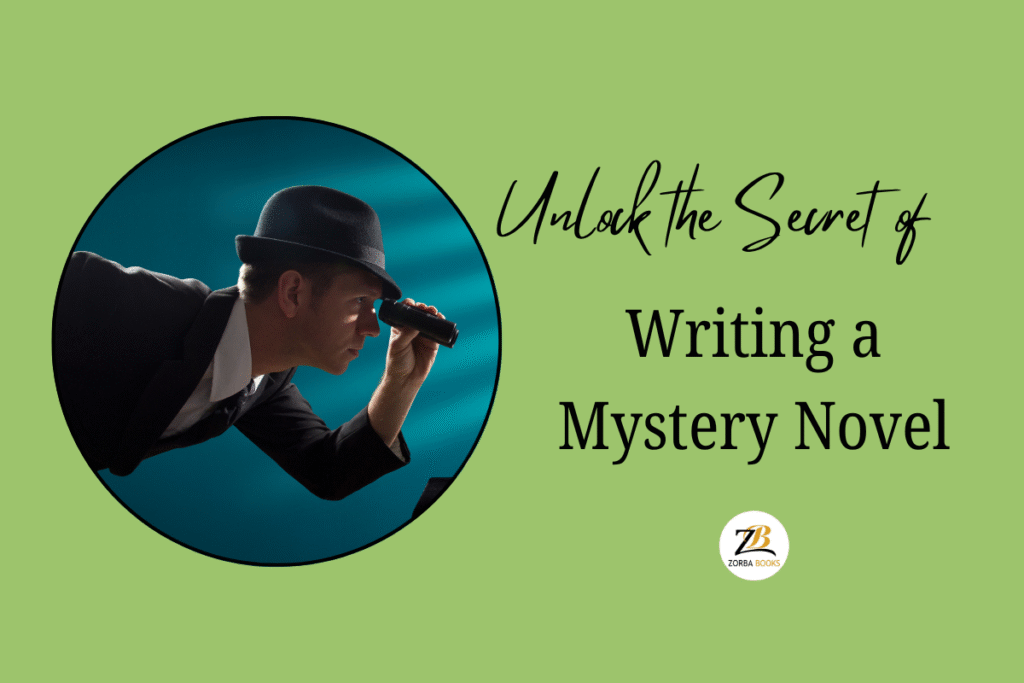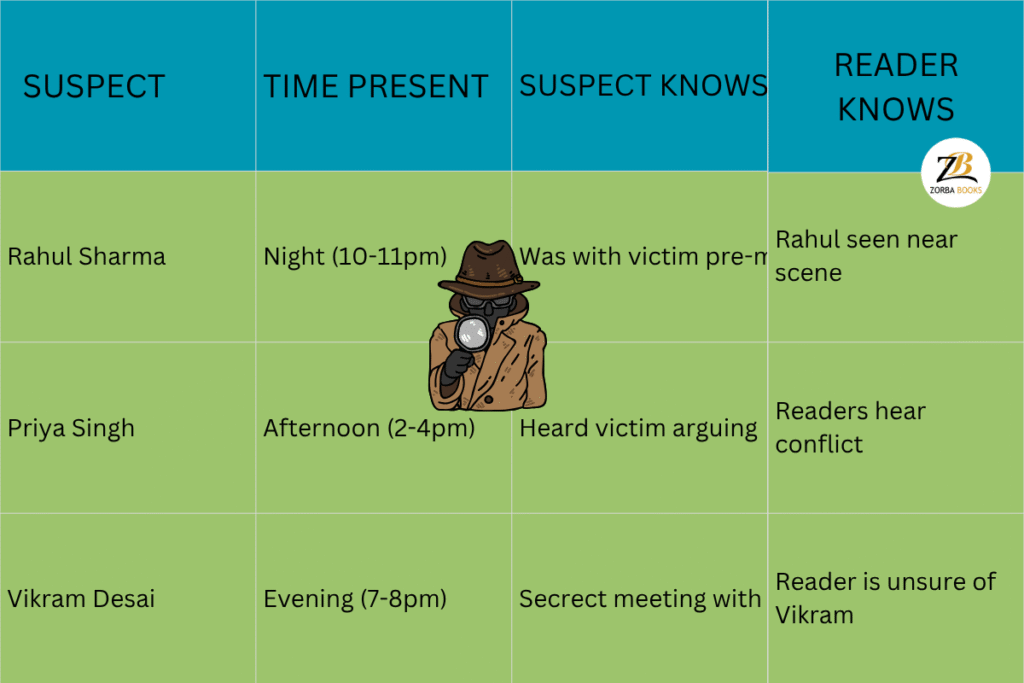
Writing a Mystery Novel
- Why Is It So Hard to Hook Readers from the First Page?
- How Do I Write Flawed Yet Relatable Protagonists?
- How Can I Blend Genres Without Losing Focus?
- How Do I Get the Details Right So My Plot Feels Real?
- How Do I Introduce Red Herrings Without Confusing My Readers?
- How Do I Use Settings Liked by Indian Readers to Build Suspense?
- Where Can I Find Inspiration for Plot Twists and Motives?
- How Do I Write Authentic Police Procedures without Insider Access?
- Which Modern Themes and Social Issues Work Best for Mystery Books in India?
- Best Themes for Mystery Books in India (2025 Trends)
- How Can I Promote My Mystery Novel and Reach Indian Readers?
- Quick-Reference Table
Writing a mystery novel remains one of the most thrilling yet challenging literary journeys—one packed with killer plots, layered suspects, and endless opportunities to capture the imagination of readers. If you’ve often wondered how to write a mystery novel, struggled with where to begin, or felt stuck along the way, this comprehensive 2025 guide is crafted for you. Each major challenge is answered—so you can zero in on your pain points and find actionable advice, vivid examples, and inspiring solutions.
1. Why Is It So Hard to Hook Readers from the First Page?
Suspense at First Sight
The first chapter must seize readers instantly—setting the stakes and hinting at the core crime. Many tips for debut Indian crime writers grapple with getting to “the good part” soon enough.
Solution & Example:
Open with the crime or a gripping clue. The Blue Bar by Damyanti Biswas dives into Mumbai’s nightlife with tension from the start. Create an atmosphere—rain-washed streets, a mysterious disappearance, or a cryptic note left behind.
2. How Do I Write Flawed Yet Relatable Protagonists?
Making the Reader a Cheerleader
It’s tempting to make your detective perfect, but flaws build connection. Writers fear making protagonists “unlikable” or too vulnerable.
Solution & Example:
Let your sleuth have baggage—past failures, impostor syndrome, family drama. In Abir Mukherjee’s Wyndham & Banerjee series, the detectives face colonial racism and personal demons, deepening their authenticity.
3. How Can I Blend Genres Without Losing Focus?
Which Mystery Are You?
Combining romance, comedy, or the paranormal feels risky for new authors unsure of “rules.”
Solution & Example:
Look at books like Nine or the Vish Puri series by Tarquin Hall, which blend Indian humour with tight plotting. Start by reading your favorite cross-genre mysteries for inspiration and structure.
4. How Do I Get the Details Right So My Plot Feels Real?
Sticking to Details
Many debut Indian crime writers find keeping track of timelines, alibis, and clues overwhelming, leading to plot holes or magical solutions.
Solution & Example:
Use a simple chart, timeline, or story graph that notes when each suspect is present, what they know, and what the reader knows. Vish Dhamija’s legal thrillers shine because they respect process and logic—every clue matters, and nothing is left to chance.

How to use this chart:
- List each key suspect down the rows.
- For every major scene or pivotal time, note when each suspect is present or absent.
- Track what critical detail each suspect knows at that time—for example, who they saw, alibi details, or secrets.
- In the final column, record which facts have been revealed to the reader so far, helping you manage clue delivery and red herrings effectively.
Another good tip is to make a graph of your story for example, if the protagonist encounters a question, make the line go down. If he finds the answer to a question, then make the line go up. If there are non-mystery related scenes, then make the line go straight. This will help your story gain balance. It will also help you introduce excitement, areas of elation and despair for the reader in your story.

By maintaining this overview as you write, you ensure that your plot stays logical, your twists remain fair, and your readers stay hooked and satisfied.
5. How Do I Introduce Red Herrings Without Confusing My Readers?
Mastering Red Herrings
Too many false leads can make a Indian detective fiction feel chaotic; too few and it’s predictable.
Solution & Example:
Introduce characters with plausible motives—like the office peon who knows everyone’s secrets or the village postman who delivers both news and lies. Inspector Chopra mysteries use Mumbai’s festivals and chaos as camouflage for red herrings, each resolved with logic later in the narrative.
Red Herrings are fun as they keep the reader on their toes, but don’t overdo it to the extent that there’s a false lead in almost every chapter!
6. How Do I Use Settings Liked by Indian Readers to Build Suspense?
Using Setting to Create a Mystery
Some debut Indian crime writers struggle to make settings active, feeling limited by their own locality.
Solution & Example:
Transform the ordinary—chai shops, railway stations, crowded festivals—into scenes of suspicion. A Cut Like Wound by Anita Nair sets chilling crimes amid Bengaluru’s rainy, festival-lit streets, making setting a character in itself.
7. Where Can I Find Inspiration for Plot Twists and Motives?
Drawing Inspiration from Real India
Finding fresh motives beyond jealousy or revenge poses a challenge in a well-worn genre.
Solution & Example:
Dive into newspapers and true-crime podcasts. Madhumita Bhattacharyya often starts stories based on real Indian headlines—disappearances, scams, or bizarre small-town cases—amplifying truth into fiction.
8. How Do I Write Authentic Police Procedures without Insider Access?
Writing Authentic Police Procedures in Indian Fiction
When crafting suspense, writers fear inaccuracies— legal delays, or the role of social pressures can seem hard to capture.
Solution & Example:
Consult lawyers, police case logs, and regional news. Abir Mukherjee researched colonial police protocols for his Banerjee series; Vish Dhamija quotes real-world court judgments and investigative steps faithfully.
9. Which Modern Themes and Social Issues Work Best for Mystery Books in India?
Exploring the Best Themes for Indian Mysteries
Keeping stories “current” when trends change fast can be daunting. Current social issues can be an inspiration for Indian novels
Solution & Example:
For inspiration in suspense writing, a crime novel blends themes like cybercrime, caste tensions, influencer culture, and urban migration into your plot. A Burning by Megha Majumdar anchors its page-turner in class struggle and social mobility.
10. Best Themes for Mystery Books in India (2025 Trends)
Theme selection matters! The best themes for mystery books in India today aren’t just about “whodunit”—they explore the Indian experience. Consider integrating:
- Digital Crime: Leverage cyber frauds, hacking, or digital identity theft as central plot devices.
- Social Tensions: Class divides, gender issues, or corruption set powerfully authentic stakes.
- Cultural Nuances: Use festivals, traditional customs, or family secrets as crucial elements of the mystery plot.
Data Insight:
Genre sales featuring cybercrime, modern social dilemmas, or rural settings have grown by over 40% in Indian urban bookstores (Crossword Bookstores, 2024).
11. How Can I Promote My Mystery Novel and Reach Indian Readers?
Promoting Mysteries for Indian Readers
With bookshops dwindling, debut authors can feel invisible.
Solution & Example:
Leverage social media, join literary festivals (like Jaipur Lit Fest), and partner with book clubs. Tamanna C built buzz for her The Vertical Path by blogging and engaging online, far beyond the bookstore shelf.
12. Quick-Reference Table:

| Pain Point Question | Example from Indian Fiction | Action Step |
| How to hook from page one? | The Blue Bar (Biswas) | Start with a tense image or the crime itself |
| How to create flawed protagonists? | Wyndham & Banerjee (Mukherjee) | Show internal conflicts and vulnerabilities |
| How to mix genres smartly? | Vish Puri series (Tarquin Hall) | Study structure in hybrid-genre bestsellers |
| How to keep details & timelines straight? | Legal thrillers (Vish Dhamija) | Chart clues/events chapter by chapter |
| How to use red herrings well? | Inspector Chopra (Khan) | Logical, setting-based misdirections |
| How to build suspense with setting? | A Cut Like Wound (Nair) | Use festivals, city chaos as backdrops |
| How to find new motives? | Reema Ray series (Bhattacharyya) | Mine news, podcasts, and real headlines |
| How to write police realism? | Banerjee series (Mukherjee), Dhamija | Interview experts, use official documents |
| Which themes engage 2025 readers? | A Burning (Majumdar), The Blue Bar | Tackle cybercrime, class, cultural change |
| How to promote to Indian readers? | Kiran Manral’s blog/festival presence | Go digital, attend festivals, engage clubs |
Call to Action
Are you ready to turn your mystery idea into India’s next must-read thriller? Share these tips for debut Indian crime writers with fellow writers, join a literary community, or reach out for help polishing your draft!
If you’re seeking expert support, guidance, or a publishing partner for your mystery book publishing, who understands the evolving Indian market, consider connecting with Zorba Books—a home for passionate new mystery voices.
Start plotting today—your story is the next great twist Indian readers are waiting for! These are just some of the tips for how to write a crime novel outline that we hope will inspire you to write your mystery novel. It is a genre which readers can never tire of! How to write a mystery novel outline
Read an interview of a bestselling mystery novelist.
To know more about writing a book in other genres, childrens book, biography, memoire, poems, short-stories
How to Write a Children’s Book: Invaluable Tips
Autobiography, Biography, and Memoir: Three Different Ways to Tell Your Life Story
Writing Short Stories: Book Guide
Launched a Free Blog and Book Platform
Discover more from ZorbaBooks
Subscribe to get the latest posts sent to your email.
Pingback: Writing Short-stories that standout
Pingback: A guide to writing engaging stories
Pingback: Tips to write a childrens book
Pingback: Should I write and what should I write? - ZorbaBooks
Awesome article really helps. Thanks for sharing Zorba. Keep on sharing articles like this. Writing murder mystery books is not as easy as it seems. It takes a great amount of time, effort, and knowledge to come up with stories that can fit the standard of murder mystery.
Thanks
Regards,
JB
Thank you. We are glad you liked the article.
Nice beginning. We will love to have more such lessons.
Pingback: Interview with Indian Author of Crime Fiction - Madhumita Bhattacharyya - ZorbaBooks
Pingback: Five Secrets to an Eye Catching Book Cover - ZorbaBooks
Pingback: Six Secrets Of How to Write a Romantic Novel, Revealed - ZorbaBooks
Pingback: FAQ's on Writing a Book - ZorbaBooks
Pingback: How to Compile an Anthology and Publish it? - ZorbaBooks
Pingback: Delight the Reader, write Dialogues Using These 11 Tips - ZorbaBooks
Pingback: Book Title Ideas: Choosing Your Own - ZorbaBooks
Pingback: Publishing a Book? Number of Pages Matter - ZorbaBooks
Pingback: How to Write a Book in Different Genres | Zorba Books FAQ Guide